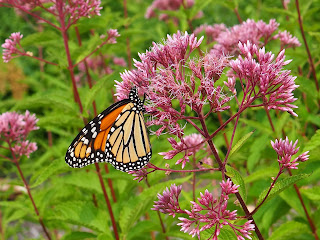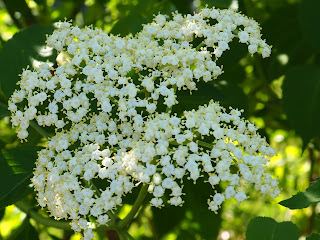These Happy Golden Days: August at the Preserve
As summer winds to a close, I wanted to highlight some of my most cherished late season flowers.
Over the last seven weeks, I have been monitoring pollinators at the preserve with an environmental educator from Stratford through UConn's Conservation Training Partnership Program. Each week, we choose three sample areas to observe, each a 5 x 5 square foot area with a different plant species. We record the number of native bees, honey bees, flies, butterflies, and other insects (such as ants, beetles, and wasps) that land on the flowers during a five minute window. We also record environmental variables such as temperature, wind speed, cloud cover, humidity, the date of last precipitation, and disturbance, since pollinator activity is connected to these factors.
 |
| Monitoring pollinators at the preserve |
So far, we have monitored 10 plant species, all highlighted on the blog: swamp milkweed, bee balm, spotted Joe Pye weed, purple loosestrife, white wood aster, Asiatic dayflower, hedge bindweed, goldenrod, jewelweed, and common boneset. Seven are native to Connecticut, while Asiatic dayflower, purple loosestrife, and hedge bindweed are invasive.
Hedge bindweed, Joe Pye weed, goldenrod, common boneset, and white wood aster attracted the most pollinators.
Each head of flowers on spotted Joe Pye weed (Eutrochium maculatum), a native perennial, consists of 8 to 20 disk florets but no ray florets. The abundant nectar of the flowers attracts honey bees, bumblebees, long-horned bees, leaf-cutting bees, bee flies, wasps, hummingbirds, butterflies, skippers, and moths. Joe Pye weed provides continuous bloom from mid to late summer, a time when many other species have stopped flowering.
 |
| A monarch butterfly (Danaus plexippus) sips nectar from Joe Pye weed |
On August 20, we observed the highest pollinator abundance on Joe Pye weed. The plant had 28 native bees, 2 honey bees, 1 butterfly and 2 other visitors. On other days during its peak flowering period, we also observed 23, 13, and 8 pollinator species on the plant.
No plant better evokes the atmosphere of late summer than goldenrod. There are over 100 species in the genus Solidago, all accustomed to different soil and light conditions. While many blame goldenrod for fall allergies, goldenrod does not produce wind-borne pollen and ragweed, which blooms at the same time, is the real culprit. In fact, the pollen of goldenrod is heavy and sticky, to facilitate the pollination process. Long-tongued bees, short-tongued bees, flies, butterflies, solitary wasps, and soldier beetles are strongly attracted to the flowers, both for the color and abundant pollen and nectar. Honey bees frequently collect large amounts of goldenrod nectar, which often contains high sugar concentrations, as a food source for winter.
On August 5, we observed 12 native bees, 1 honey bee, 1 fly, and 10 other species on a sample area with Joe Pye weed and seaside goldenrod (Solidago sempervirens).
 |
| A Halictid bee (Halictus ssp) visits goldenrod |
 |
| Common Eastern bumble bee (Bombus impatiens) is commonly encountered in our area |
Native to dry open woods in the Eastern US, white wood aster (Eurybia divaricata) provides late-season nectar for butterflies and bees. The plant grows vigorously in shade and tolerates drought. Its distinctive leaves are heart shaped and the flowers, composed of ray and disk florets, appear in terminal clusters in later summer and early fall. White wood aster is also the host plant of the pearly crescent and checkerspot butterflies. The seeds provide a food source to migratory and winter-resident birds in the fall.
On August 20, we observed 10 native bees, 1 fly, and 1 other species on white wood aster.
 |
| White wood aster has heart shaped leaves at ground level and small ovate leaves further up the stem |
Common boneset (Eupatorium perfoliatum) attracts numerous species with its fragrant flowers and highly accessible nectar. Flies, wasps, butterflies, beetles, and native bee species, including sweat bees, carpenter bees, digger bees, and bumble bees, are all common visitors to the plant from August to late September. The seeds of common boneset can supplement the diet of swamp sparrow. Like Joe Pye weed, the composite flowers bear many disk florets but no ray florets.
On August 12, we observed 6 native bees, 1 honey bee, 2 butterflies, 2 flies, and 2 other species on common boneset.
 |
| The name common boneset may reference the historical use of the plant to aid in healing broken bones |
On August 5, we were surprised to notice 24 native bees, 4 flies, and 9 other species on hedge bindweed (Calystegia sepium), a non-native species at the preserve. Hedge bindweed has an extensive underground root system. It can grow in a wide range of conditions and twists around surrounding vegetation in a clockwise direction for support. Nonetheless, it is also said to attract butterflies and moths.
 |
| "Look like the innocent flower but be the serpent under't" (Macbeth 1.5:74-5). The creeping roots of hedge bindweed can extend 10 feet or more in length. |
Through our project, we wanted to demonstrate the connection between plant biodiversity and pollinator abundance. All of these native perennials are easy to grow from seed, and an excellent way to bring pollinators home and support the Green Corridor Initiative!
If anything can test the resilience and ecological importance of native plants, it would be Storm Isaias. When a tree fell down in the middle of the preserve, a few uprooted Joe Pye weed plants held on for several weeks.
 |
| The tree fell over the power lines and the sign at the entrance to the preserve |
 |
| Nature continues, resilient, through the last golden days of summer |






Comments
Post a Comment